International Business Challenges: Subway's Risks and Ford's Ventures
VerifiedAdded on 2022/10/08
|9
|1298
|19
Homework Assignment
AI Summary
This assignment delves into the complexities of international business, using Subway and Ford Motor Company as case studies. It examines the risks Subway faces when expanding internationally, including legal issues and political instability, and their potential impacts on the business. The assignment also analyzes the advantages and disadvantages Ford encounters in non-equity joint ventures, such as the benefits of shared knowledge and risk mitigation, alongside the challenges of cultural differences and potential conflicts. The student utilizes provided resources to support their arguments, illustrating the crucial need for careful planning and risk management in global business ventures.
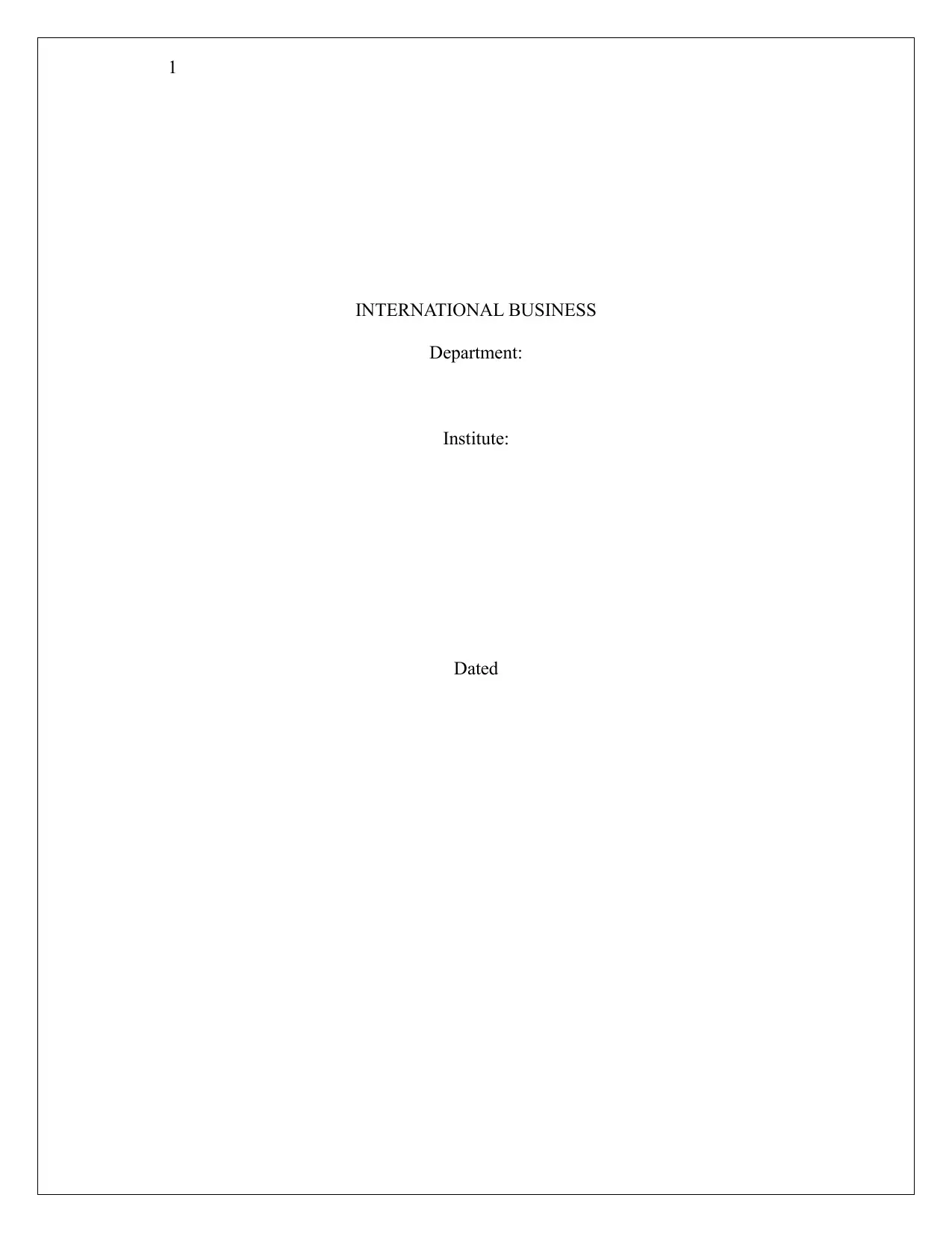
1
INTERNATIONAL BUSINESS
Department:
Institute:
Dated
INTERNATIONAL BUSINESS
Department:
Institute:
Dated
Paraphrase This Document
Need a fresh take? Get an instant paraphrase of this document with our AI Paraphraser
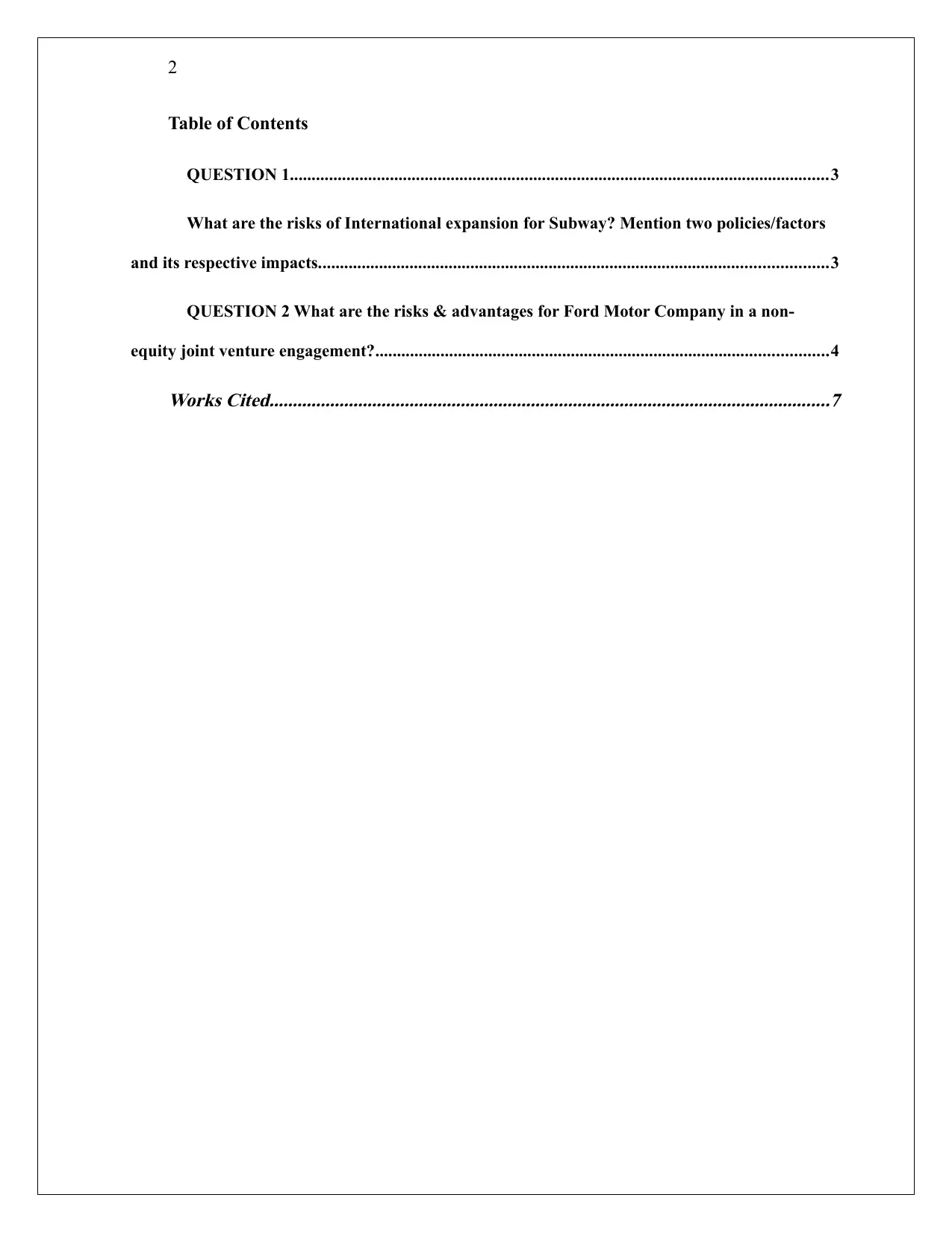
2
Table of Contents
QUESTION 1............................................................................................................................3
What are the risks of International expansion for Subway? Mention two policies/factors
and its respective impacts.....................................................................................................................3
QUESTION 2 What are the risks & advantages for Ford Motor Company in a non-
equity joint venture engagement?........................................................................................................4Works Cited........................................................................................................................7
Table of Contents
QUESTION 1............................................................................................................................3
What are the risks of International expansion for Subway? Mention two policies/factors
and its respective impacts.....................................................................................................................3
QUESTION 2 What are the risks & advantages for Ford Motor Company in a non-
equity joint venture engagement?........................................................................................................4Works Cited........................................................................................................................7
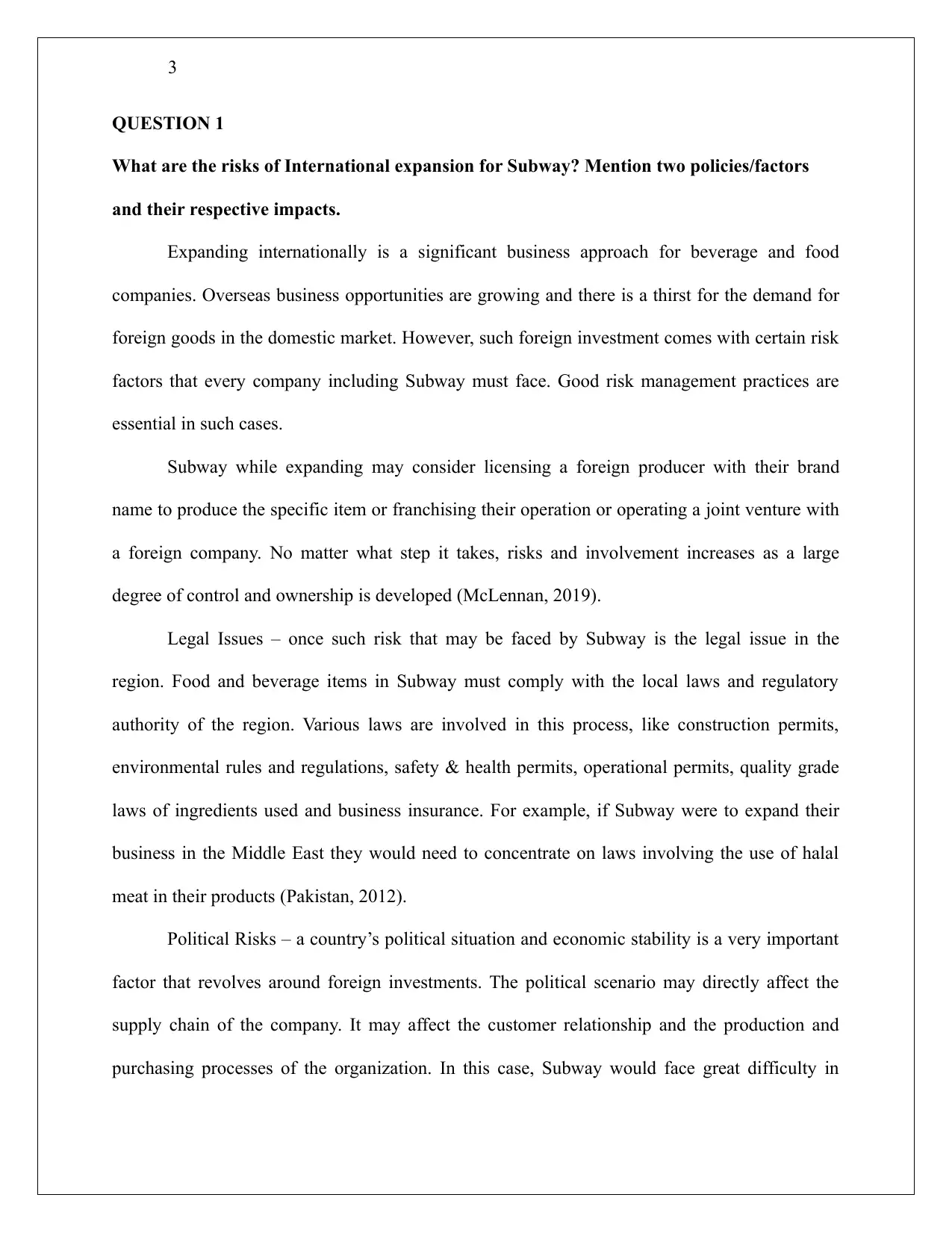
3
QUESTION 1
What are the risks of International expansion for Subway? Mention two policies/factors
and their respective impacts.
Expanding internationally is a significant business approach for beverage and food
companies. Overseas business opportunities are growing and there is a thirst for the demand for
foreign goods in the domestic market. However, such foreign investment comes with certain risk
factors that every company including Subway must face. Good risk management practices are
essential in such cases.
Subway while expanding may consider licensing a foreign producer with their brand
name to produce the specific item or franchising their operation or operating a joint venture with
a foreign company. No matter what step it takes, risks and involvement increases as a large
degree of control and ownership is developed (McLennan, 2019).
Legal Issues – once such risk that may be faced by Subway is the legal issue in the
region. Food and beverage items in Subway must comply with the local laws and regulatory
authority of the region. Various laws are involved in this process, like construction permits,
environmental rules and regulations, safety & health permits, operational permits, quality grade
laws of ingredients used and business insurance. For example, if Subway were to expand their
business in the Middle East they would need to concentrate on laws involving the use of halal
meat in their products (Pakistan, 2012).
Political Risks – a country’s political situation and economic stability is a very important
factor that revolves around foreign investments. The political scenario may directly affect the
supply chain of the company. It may affect the customer relationship and the production and
purchasing processes of the organization. In this case, Subway would face great difficulty in
QUESTION 1
What are the risks of International expansion for Subway? Mention two policies/factors
and their respective impacts.
Expanding internationally is a significant business approach for beverage and food
companies. Overseas business opportunities are growing and there is a thirst for the demand for
foreign goods in the domestic market. However, such foreign investment comes with certain risk
factors that every company including Subway must face. Good risk management practices are
essential in such cases.
Subway while expanding may consider licensing a foreign producer with their brand
name to produce the specific item or franchising their operation or operating a joint venture with
a foreign company. No matter what step it takes, risks and involvement increases as a large
degree of control and ownership is developed (McLennan, 2019).
Legal Issues – once such risk that may be faced by Subway is the legal issue in the
region. Food and beverage items in Subway must comply with the local laws and regulatory
authority of the region. Various laws are involved in this process, like construction permits,
environmental rules and regulations, safety & health permits, operational permits, quality grade
laws of ingredients used and business insurance. For example, if Subway were to expand their
business in the Middle East they would need to concentrate on laws involving the use of halal
meat in their products (Pakistan, 2012).
Political Risks – a country’s political situation and economic stability is a very important
factor that revolves around foreign investments. The political scenario may directly affect the
supply chain of the company. It may affect the customer relationship and the production and
purchasing processes of the organization. In this case, Subway would face great difficulty in
⊘ This is a preview!⊘
Do you want full access?
Subscribe today to unlock all pages.

Trusted by 1+ million students worldwide
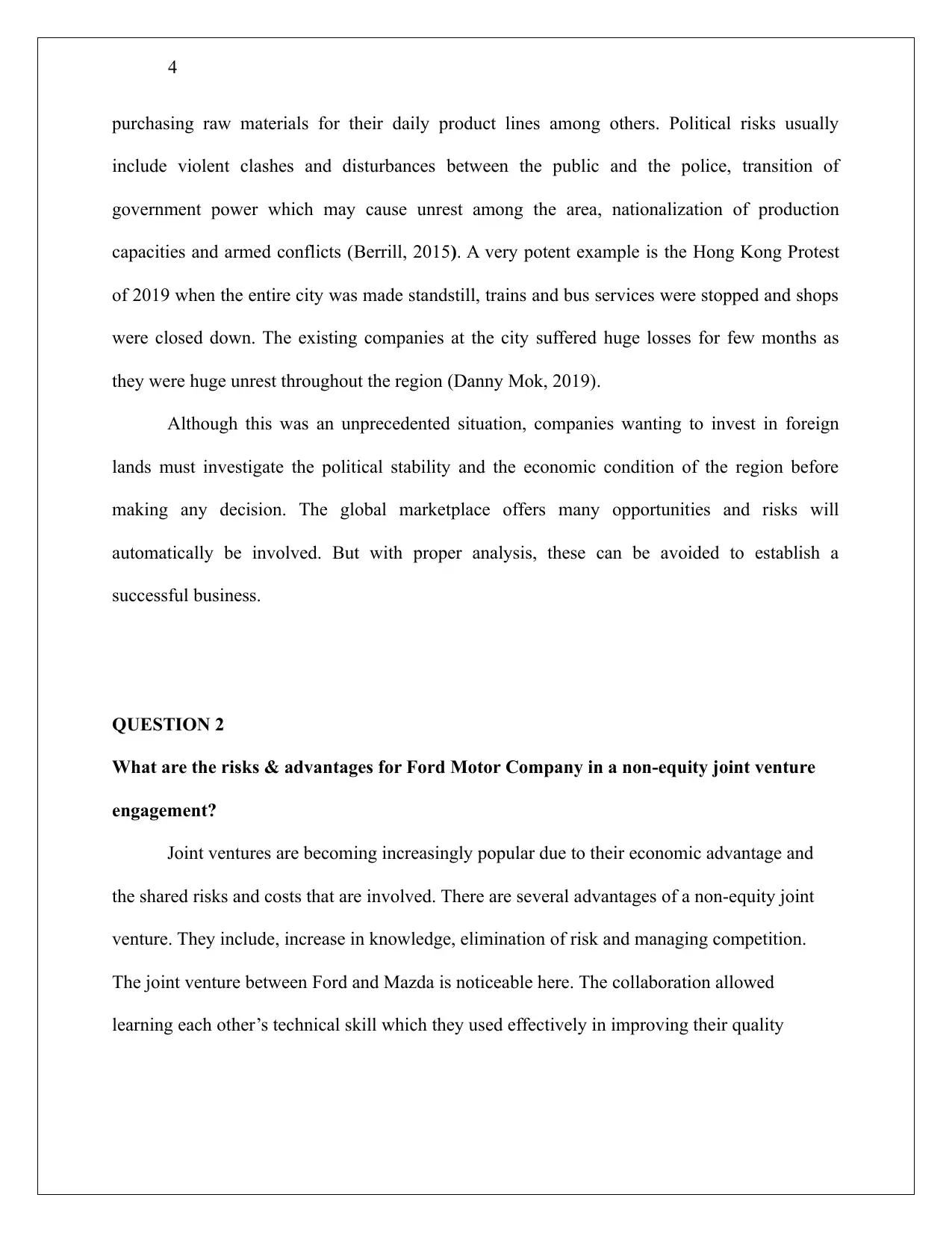
4
purchasing raw materials for their daily product lines among others. Political risks usually
include violent clashes and disturbances between the public and the police, transition of
government power which may cause unrest among the area, nationalization of production
capacities and armed conflicts (Berrill, 2015). A very potent example is the Hong Kong Protest
of 2019 when the entire city was made standstill, trains and bus services were stopped and shops
were closed down. The existing companies at the city suffered huge losses for few months as
they were huge unrest throughout the region (Danny Mok, 2019).
Although this was an unprecedented situation, companies wanting to invest in foreign
lands must investigate the political stability and the economic condition of the region before
making any decision. The global marketplace offers many opportunities and risks will
automatically be involved. But with proper analysis, these can be avoided to establish a
successful business.
QUESTION 2
What are the risks & advantages for Ford Motor Company in a non-equity joint venture
engagement?
Joint ventures are becoming increasingly popular due to their economic advantage and
the shared risks and costs that are involved. There are several advantages of a non-equity joint
venture. They include, increase in knowledge, elimination of risk and managing competition.
The joint venture between Ford and Mazda is noticeable here. The collaboration allowed
learning each other’s technical skill which they used effectively in improving their quality
purchasing raw materials for their daily product lines among others. Political risks usually
include violent clashes and disturbances between the public and the police, transition of
government power which may cause unrest among the area, nationalization of production
capacities and armed conflicts (Berrill, 2015). A very potent example is the Hong Kong Protest
of 2019 when the entire city was made standstill, trains and bus services were stopped and shops
were closed down. The existing companies at the city suffered huge losses for few months as
they were huge unrest throughout the region (Danny Mok, 2019).
Although this was an unprecedented situation, companies wanting to invest in foreign
lands must investigate the political stability and the economic condition of the region before
making any decision. The global marketplace offers many opportunities and risks will
automatically be involved. But with proper analysis, these can be avoided to establish a
successful business.
QUESTION 2
What are the risks & advantages for Ford Motor Company in a non-equity joint venture
engagement?
Joint ventures are becoming increasingly popular due to their economic advantage and
the shared risks and costs that are involved. There are several advantages of a non-equity joint
venture. They include, increase in knowledge, elimination of risk and managing competition.
The joint venture between Ford and Mazda is noticeable here. The collaboration allowed
learning each other’s technical skill which they used effectively in improving their quality
Paraphrase This Document
Need a fresh take? Get an instant paraphrase of this document with our AI Paraphraser
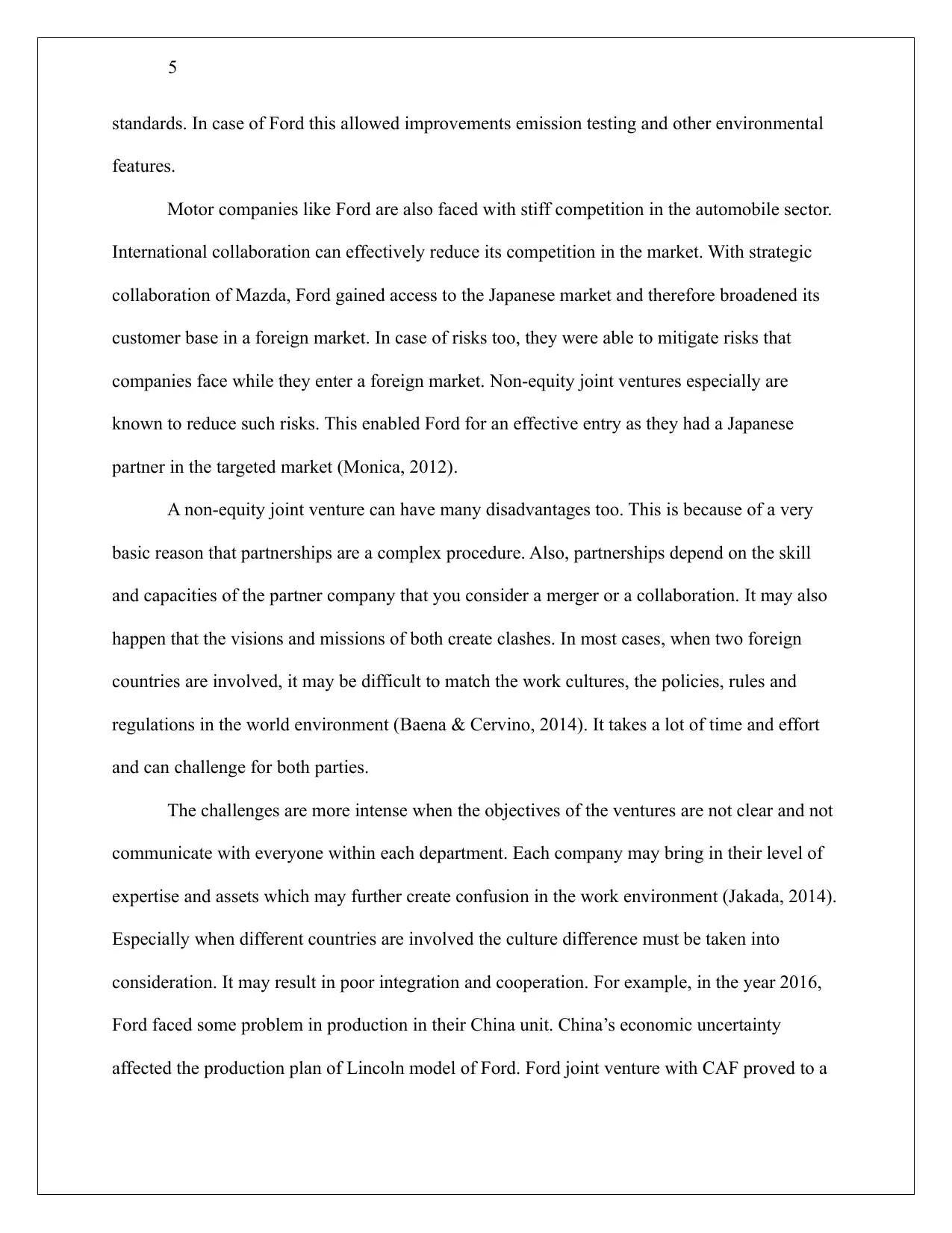
5
standards. In case of Ford this allowed improvements emission testing and other environmental
features.
Motor companies like Ford are also faced with stiff competition in the automobile sector.
International collaboration can effectively reduce its competition in the market. With strategic
collaboration of Mazda, Ford gained access to the Japanese market and therefore broadened its
customer base in a foreign market. In case of risks too, they were able to mitigate risks that
companies face while they enter a foreign market. Non-equity joint ventures especially are
known to reduce such risks. This enabled Ford for an effective entry as they had a Japanese
partner in the targeted market (Monica, 2012).
A non-equity joint venture can have many disadvantages too. This is because of a very
basic reason that partnerships are a complex procedure. Also, partnerships depend on the skill
and capacities of the partner company that you consider a merger or a collaboration. It may also
happen that the visions and missions of both create clashes. In most cases, when two foreign
countries are involved, it may be difficult to match the work cultures, the policies, rules and
regulations in the world environment (Baena & Cervino, 2014). It takes a lot of time and effort
and can challenge for both parties.
The challenges are more intense when the objectives of the ventures are not clear and not
communicate with everyone within each department. Each company may bring in their level of
expertise and assets which may further create confusion in the work environment (Jakada, 2014).
Especially when different countries are involved the culture difference must be taken into
consideration. It may result in poor integration and cooperation. For example, in the year 2016,
Ford faced some problem in production in their China unit. China’s economic uncertainty
affected the production plan of Lincoln model of Ford. Ford joint venture with CAF proved to a
standards. In case of Ford this allowed improvements emission testing and other environmental
features.
Motor companies like Ford are also faced with stiff competition in the automobile sector.
International collaboration can effectively reduce its competition in the market. With strategic
collaboration of Mazda, Ford gained access to the Japanese market and therefore broadened its
customer base in a foreign market. In case of risks too, they were able to mitigate risks that
companies face while they enter a foreign market. Non-equity joint ventures especially are
known to reduce such risks. This enabled Ford for an effective entry as they had a Japanese
partner in the targeted market (Monica, 2012).
A non-equity joint venture can have many disadvantages too. This is because of a very
basic reason that partnerships are a complex procedure. Also, partnerships depend on the skill
and capacities of the partner company that you consider a merger or a collaboration. It may also
happen that the visions and missions of both create clashes. In most cases, when two foreign
countries are involved, it may be difficult to match the work cultures, the policies, rules and
regulations in the world environment (Baena & Cervino, 2014). It takes a lot of time and effort
and can challenge for both parties.
The challenges are more intense when the objectives of the ventures are not clear and not
communicate with everyone within each department. Each company may bring in their level of
expertise and assets which may further create confusion in the work environment (Jakada, 2014).
Especially when different countries are involved the culture difference must be taken into
consideration. It may result in poor integration and cooperation. For example, in the year 2016,
Ford faced some problem in production in their China unit. China’s economic uncertainty
affected the production plan of Lincoln model of Ford. Ford joint venture with CAF proved to a
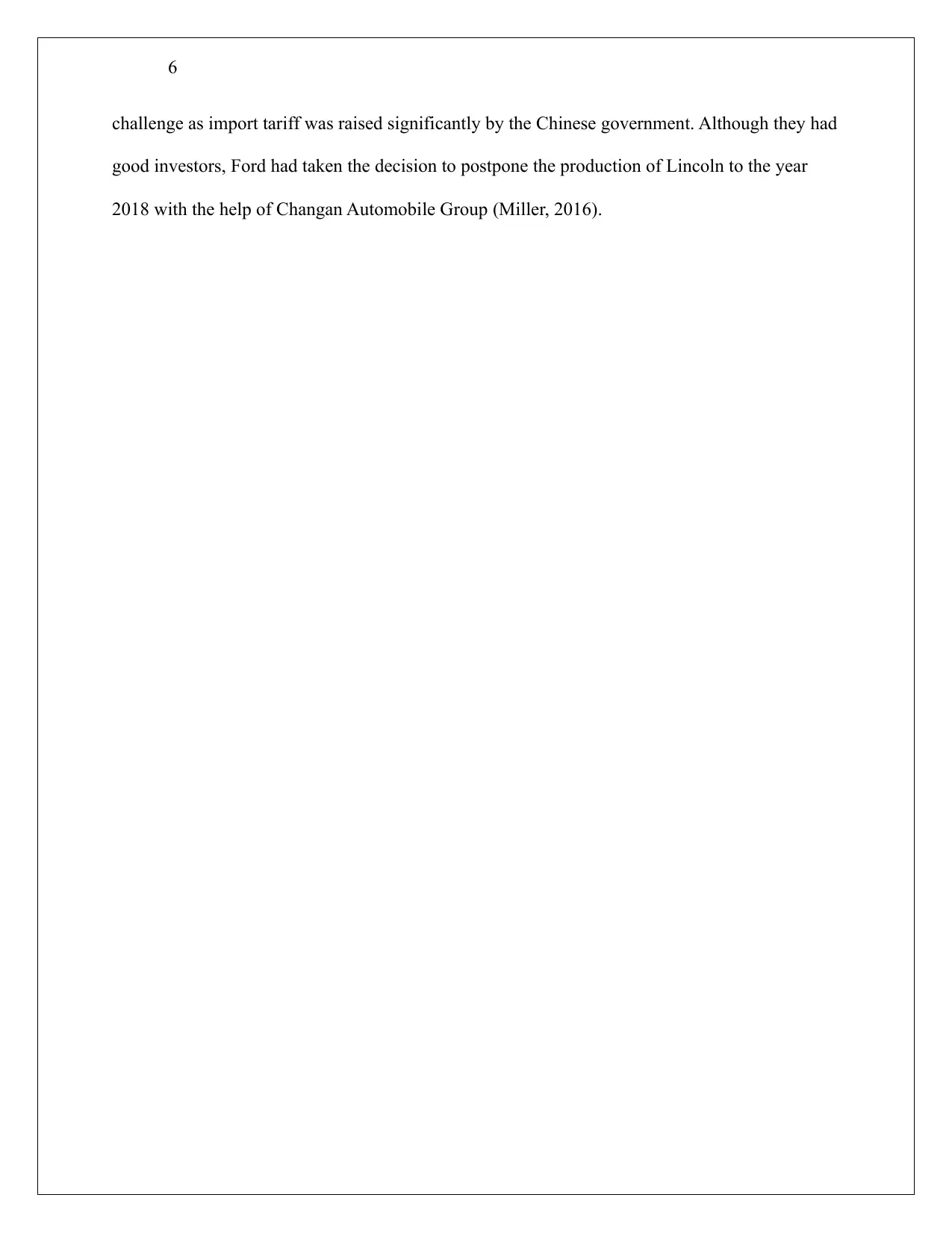
6
challenge as import tariff was raised significantly by the Chinese government. Although they had
good investors, Ford had taken the decision to postpone the production of Lincoln to the year
2018 with the help of Changan Automobile Group (Miller, 2016).
challenge as import tariff was raised significantly by the Chinese government. Although they had
good investors, Ford had taken the decision to postpone the production of Lincoln to the year
2018 with the help of Changan Automobile Group (Miller, 2016).
⊘ This is a preview!⊘
Do you want full access?
Subscribe today to unlock all pages.

Trusted by 1+ million students worldwide
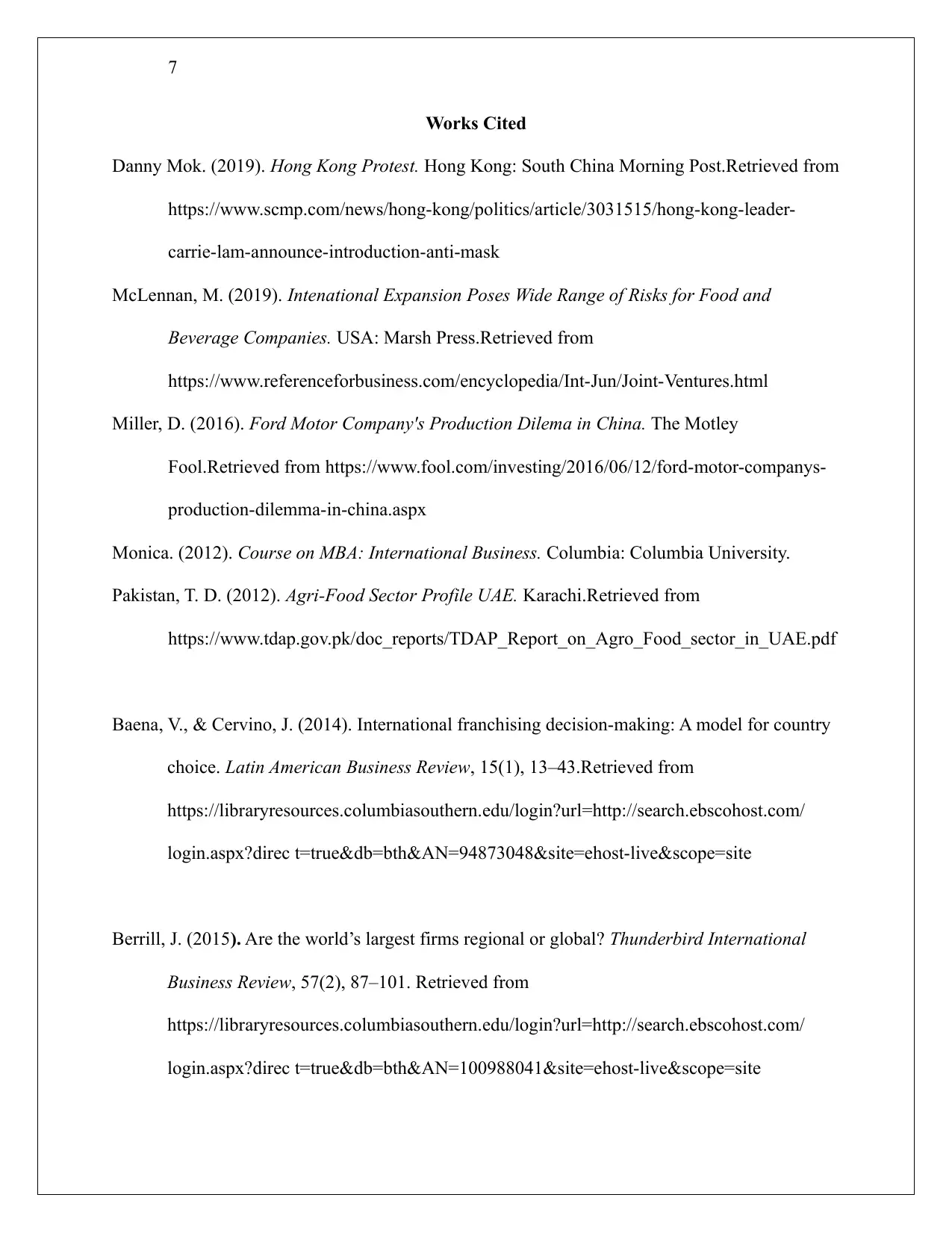
7
Works Cited
Danny Mok. (2019). Hong Kong Protest. Hong Kong: South China Morning Post.Retrieved from
https://www.scmp.com/news/hong-kong/politics/article/3031515/hong-kong-leader-
carrie-lam-announce-introduction-anti-mask
McLennan, M. (2019). Intenational Expansion Poses Wide Range of Risks for Food and
Beverage Companies. USA: Marsh Press.Retrieved from
https://www.referenceforbusiness.com/encyclopedia/Int-Jun/Joint-Ventures.html
Miller, D. (2016). Ford Motor Company's Production Dilema in China. The Motley
Fool.Retrieved from https://www.fool.com/investing/2016/06/12/ford-motor-companys-
production-dilemma-in-china.aspx
Monica. (2012). Course on MBA: International Business. Columbia: Columbia University.
Pakistan, T. D. (2012). Agri-Food Sector Profile UAE. Karachi.Retrieved from
https://www.tdap.gov.pk/doc_reports/TDAP_Report_on_Agro_Food_sector_in_UAE.pdf
Baena, V., & Cervino, J. (2014). International franchising decision-making: A model for country
choice. Latin American Business Review, 15(1), 13–43.Retrieved from
https://libraryresources.columbiasouthern.edu/login?url=http://search.ebscohost.com/
login.aspx?direc t=true&db=bth&AN=94873048&site=ehost-live&scope=site
Berrill, J. (2015). Are the world’s largest firms regional or global? Thunderbird International
Business Review, 57(2), 87–101. Retrieved from
https://libraryresources.columbiasouthern.edu/login?url=http://search.ebscohost.com/
login.aspx?direc t=true&db=bth&AN=100988041&site=ehost-live&scope=site
Works Cited
Danny Mok. (2019). Hong Kong Protest. Hong Kong: South China Morning Post.Retrieved from
https://www.scmp.com/news/hong-kong/politics/article/3031515/hong-kong-leader-
carrie-lam-announce-introduction-anti-mask
McLennan, M. (2019). Intenational Expansion Poses Wide Range of Risks for Food and
Beverage Companies. USA: Marsh Press.Retrieved from
https://www.referenceforbusiness.com/encyclopedia/Int-Jun/Joint-Ventures.html
Miller, D. (2016). Ford Motor Company's Production Dilema in China. The Motley
Fool.Retrieved from https://www.fool.com/investing/2016/06/12/ford-motor-companys-
production-dilemma-in-china.aspx
Monica. (2012). Course on MBA: International Business. Columbia: Columbia University.
Pakistan, T. D. (2012). Agri-Food Sector Profile UAE. Karachi.Retrieved from
https://www.tdap.gov.pk/doc_reports/TDAP_Report_on_Agro_Food_sector_in_UAE.pdf
Baena, V., & Cervino, J. (2014). International franchising decision-making: A model for country
choice. Latin American Business Review, 15(1), 13–43.Retrieved from
https://libraryresources.columbiasouthern.edu/login?url=http://search.ebscohost.com/
login.aspx?direc t=true&db=bth&AN=94873048&site=ehost-live&scope=site
Berrill, J. (2015). Are the world’s largest firms regional or global? Thunderbird International
Business Review, 57(2), 87–101. Retrieved from
https://libraryresources.columbiasouthern.edu/login?url=http://search.ebscohost.com/
login.aspx?direc t=true&db=bth&AN=100988041&site=ehost-live&scope=site
Paraphrase This Document
Need a fresh take? Get an instant paraphrase of this document with our AI Paraphraser
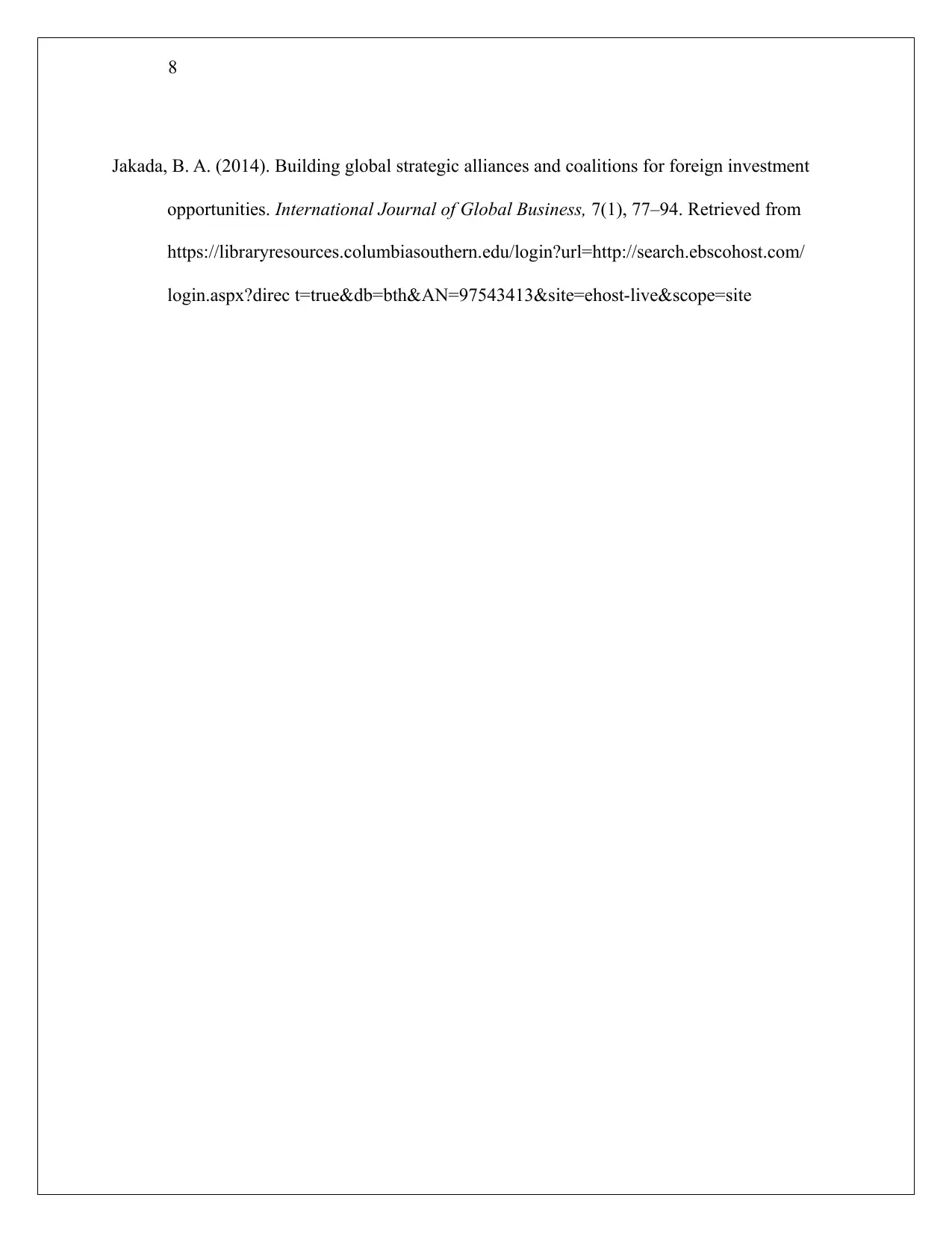
8
Jakada, B. A. (2014). Building global strategic alliances and coalitions for foreign investment
opportunities. International Journal of Global Business, 7(1), 77–94. Retrieved from
https://libraryresources.columbiasouthern.edu/login?url=http://search.ebscohost.com/
login.aspx?direc t=true&db=bth&AN=97543413&site=ehost-live&scope=site
Jakada, B. A. (2014). Building global strategic alliances and coalitions for foreign investment
opportunities. International Journal of Global Business, 7(1), 77–94. Retrieved from
https://libraryresources.columbiasouthern.edu/login?url=http://search.ebscohost.com/
login.aspx?direc t=true&db=bth&AN=97543413&site=ehost-live&scope=site

9
⊘ This is a preview!⊘
Do you want full access?
Subscribe today to unlock all pages.

Trusted by 1+ million students worldwide
1 out of 9
Related Documents
Your All-in-One AI-Powered Toolkit for Academic Success.
+13062052269
info@desklib.com
Available 24*7 on WhatsApp / Email
![[object Object]](/_next/static/media/star-bottom.7253800d.svg)
Unlock your academic potential
Copyright © 2020–2025 A2Z Services. All Rights Reserved. Developed and managed by ZUCOL.





